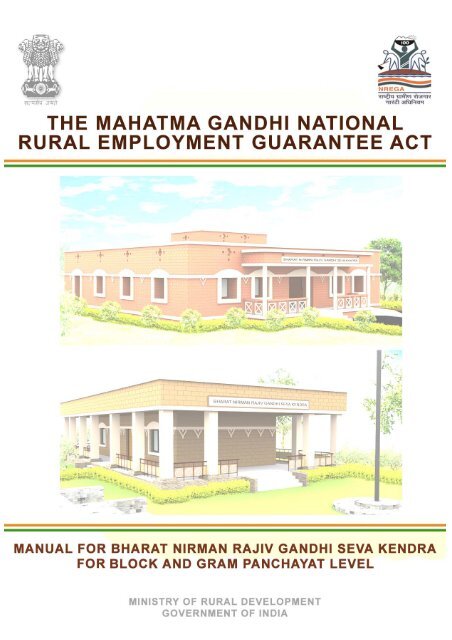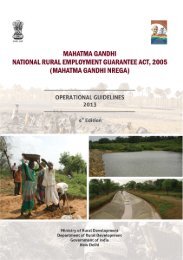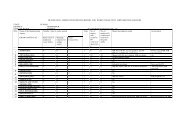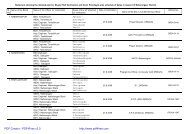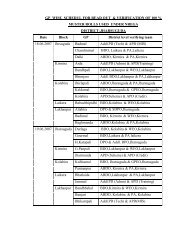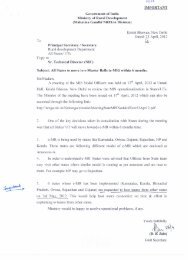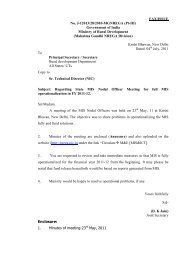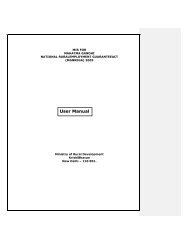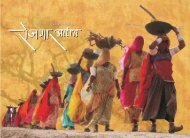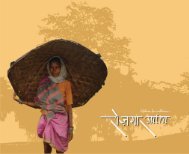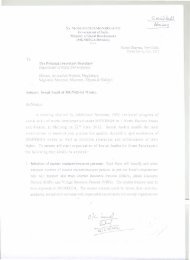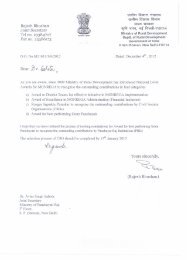Manual - National Rural Employment Guarantee Act
Manual - National Rural Employment Guarantee Act
Manual - National Rural Employment Guarantee Act
Create successful ePaper yourself
Turn your PDF publications into a flip-book with our unique Google optimized e-Paper software.
Table of Contents<br />
PART - I<br />
1. The objective of ‘The Mahatma Gandhi <strong>National</strong> <strong>Rural</strong> <strong>Employment</strong> <strong>Guarantee</strong> <strong>Act</strong>’ . 1<br />
1.1. Context ........................................................................................................................... 2<br />
1.2. Objectives ....................................................................................................................... 2<br />
1.3. Nature of <strong>Act</strong>ivities to be undertaken ............................................................................ 3<br />
1.4. Designs ........................................................................................................................... 5<br />
1.5. Conformity to MGNREGA processes in planning and execution ................................. 6<br />
1.6. Funding ........................................................................................................................... 7<br />
1.7. Monitoring and Report ................................................................................................... 7<br />
1.8. Priority ............................................................................................................................ 7<br />
PART - II<br />
2. Project Introduction ......................................................................................................... 8<br />
2.1. Project Requirements ..................................................................................................... 8<br />
3. Design Guidelines for BNRGSK at block and Gram Panchayat level ........................... 9<br />
3.1. Guidelines for BNRGSK at Block level ........................................................................ 9<br />
3.1.1. Floor Plan ..................................................................................................................... 9<br />
3.1.2. About the design ........................................................................................................ 10<br />
3.2. Suggestive Architectural forms for BNRGSK at Block level ..................................... 11<br />
3.2.1. BNRGSK at Block level for Standard General Design ............................................. 11<br />
3.2.2. BNRGSK at Block level for Hilly Areas (On stilts) .................................................. 12<br />
3.2.3. BNRGSK at Block level for Coastal Region ............................................................ 13<br />
3.2.4. BNRGSK at Block level for Heavy Rain/Snowfall Areas ......................................... 14<br />
3.3. Suggestive Architectural forms for BNRGSK at Gram Panchayat Level .................. 15<br />
3.3.1. Site plan(Alternative by COSTFORD on the principles of Laurie Baker) .............. 15<br />
3.3.2. Floor plan(Alternative by COSTFORD on the principles of Laurie Baker) ............ 16<br />
3.3.2. About the design ........................................................................................................ 16<br />
3.3.3. Perspective Views ............................................................................................................ 17<br />
3.3.4. Guidelines developed by the COSTFORD ...................................................................... 19<br />
3.3.5 Characteristics of the building developed by the COSTFORD ...................................... 19<br />
3.4.1. Floor plan ........................................................................................................................... 21<br />
3.4.2. About the design ................................................................................................................ 22
3.4.3. BNRGSK at Gram Panchayat level for Standard General Design ............................... 23<br />
3.4.4. BNRGSK at Gram Panchayat level for Hilly Areas (On Stilts) ..................................... 24<br />
3.4.5. BNRGSK at Gram Panchayat level for Coastal Region .......................................... 25<br />
3.4.6. BNRGSK. at Gram Panchayat level for Heavy Rain/Snowfall Area………………..26<br />
4.1. Design concepts ........................................................................................................... 27<br />
4.2. Landscaping .................................................................................................................. 28<br />
4.3. Aesthetics ...................................................................................................................... 28<br />
4.4.1. General design approach for extreme climate .............................................................. 29<br />
4.4.2. General design approach for area with heavey rain…………………………………..29<br />
4.4.3. General design approach for structural consideration……………………………...…30<br />
5. General Structure details………………………………………………………………...31<br />
5.1. Details of Filler Slab……………………………………………………………….….31<br />
5.2. Typical Structural details………………………………………………………….…..32
PART –I<br />
OBJECTIVE OF ‘THE MAHATMA GANDHI NATIONAL RURAL EMPLOYMENT<br />
GUARENTEE ACT’<br />
1. The objective of the Mahatma Gandhi <strong>National</strong> <strong>Rural</strong> <strong>Employment</strong> guarantee <strong>Act</strong> is to<br />
provide for the enhancement of livelihood security of the households in rural areas of the<br />
country by providing at least one hundred days of guaranteed wage employment in every<br />
financial year to every household whose adult members volunteer to do unskilled manual<br />
work.<br />
NREGA came into force on 7 th September, 2005 and its implementation was notified<br />
in phased manner. In phase I, it was introduced in 200 most backward districts of the country<br />
on 2 nd February 2006. 130 districts were further included under NREGS in phase II with<br />
effect from 1 st April, 2007. The act was notified in the remaining 274 districts of India from<br />
1 st April, 2008. The act is now effective in the entire rural areas of the country covering 618<br />
districts. The <strong>Act</strong> has recently been renamed as ‘The Mahatma Gandhi <strong>National</strong> <strong>Rural</strong><br />
<strong>Employment</strong> <strong>Guarantee</strong> <strong>Act</strong>’ (MGNREGA) vide notification dated 31-12-2009.<br />
The primary objective of the <strong>Act</strong> is augmenting wage employment. Its auxiliary<br />
objective is strengthening natural resource management through works that address causes of<br />
chronic poverty, like drought, and so encourage sustainable development.<br />
Para – 1 of Schedule- I of the <strong>Act</strong> details list of permissible works in the order of<br />
priority. Sub Para (9) of the Para – 1 empowers the Central Government to notify any other<br />
work in consultation with the State Government. As per Para 2 of Schedule I of the <strong>Act</strong>,<br />
creation of durable assets and strengthening the livelihood resource base of the rural poor<br />
shall be an important objective of the Scheme. In conformity with this, Ministry of <strong>Rural</strong><br />
1
Development has expended the scope of permissible work by incorporating construction of<br />
Bharat Nirman Rajiv Gandhi Seva Kendra (BNRGSK).<br />
1.1 Context<br />
Ministry of <strong>Rural</strong> Development, Government of India has expanded the scope of works<br />
under schedule1 Para 1(g) to include construction of Bharat Nirman Rajiv Gandhi Seva<br />
Kendra (BNRGSK) at the Gram Panchayat (GP) and Block level vide notification no<br />
S.O.2877(E) dated 11.11.09. This has been prompted by the demands from several states to<br />
strengthen the infrastructure at the Gram Panchayat and the Programme Office level to enable<br />
an efficient implementation of MGNREGA and to provide space for greater and more<br />
transparent interactions with the citizens.<br />
1.2 Objectives<br />
follows:<br />
The objectives of Bharat Nirman Rajiv Gandhi Seva Kendra (BNRGSK) are as<br />
a) Provide space to facilitate the functioning of the MGNREGA office at the<br />
GP/Block levels,<br />
b) Function as a Knowledge Resource Centre to facilitate<br />
i) Citizens access to information on MGNREGA and other <strong>Rural</strong><br />
Development Programmes<br />
ii) Provide space for facilitating dissemination of technologies and<br />
good practices for effecting convergence for durability and<br />
productivity enhancement of rural assets.<br />
iii) Operation of ICT facilities both to support GP and block office of<br />
Programme Officer (PO) as well as public excess to information<br />
and online transaction related to development process.<br />
2
1.3 Nature of <strong>Act</strong>ivities to be undertaken<br />
activities:<br />
The Bharat Nirman Rajiv Gandhi Seva Kendra (BNRGSK) may be used following<br />
a. Providing space for citizens to exercise their rights under MGNREGA,<br />
specially,<br />
i) Submit applications for job cards,<br />
ii) Submit applications for work,<br />
iii) Muster roll scrutiny<br />
iv) Complaints<br />
v) Use ICT facilities for scrutinizing their rights and entitlements<br />
under MGNREGA<br />
A section of the building will be dedicated towards facilitating interactions with<br />
MGNREGA workers and local communities.<br />
b. Providing space for establishing a dedicated office for MGNREGS at the GP<br />
and block levels. At the GP level, a section of the building will house the GP<br />
Office wherever the GP does not have a building. Where there is adequate<br />
infrastructure for the GP, the BNRGSK will be constructed as a citizen-centric<br />
Knowledge Resource Centre. As far as possible, this will be structurally<br />
connected to the GP building, or near it, to facilitate proper management and<br />
control of the resources created for MGNREGA. At the block level, the<br />
Programme Officer’s office will be located in the BNRGSK building at block<br />
level. As far as possible, this will also be structurally connected to the Block<br />
building, or near it, to facilitate proper management, coordination and control<br />
3
of the resources created for MGNREGA. The buildings at both levels should<br />
serve the following purposes:<br />
i) Providing ample space for the functioning of dedicated personnel<br />
ii) Enabling meetings, assemblies, gram sabhas at GP level<br />
iii) Supporting ICT infrastructure for MIS<br />
iv) Maintaining office records,<br />
v) Grievance redressal.<br />
vi) Enabling social audits at GP level<br />
vii) Training and Capacity Building<br />
viii) Operationalising ICT based MGNREGS MIS.<br />
ix) Providing a single window for information on MGNREGS and<br />
other rural development programmes which would ensure transparency<br />
and accountability.<br />
c. BNRGSK as a Knowledge Resource Centre will become the hub for:<br />
i. Facilitating convergence of all the schemes of rural development, as<br />
well as of convergence between RD schemes and other development<br />
programmes related to rural areas/communities.<br />
ii. Backward and forward linkages, which will be required for<br />
convergence for creating more productive and durable assets.<br />
iii. Collection and sharing of knowledge, awareness and information about<br />
other related schemes for the purpose of convergence.<br />
iv. Dissemination and use of new technology<br />
v. Capacity building and skill development<br />
4
1.4 Designs<br />
Structurally, the BNRGSK will reflect two fold objectives:<br />
a. Infrastructure support for locating the MGNREGA office at the GP and Block<br />
levels and strengthening their functioning through appropriate equipment<br />
including ICT<br />
b. Space for interactions with citizens/ local community/MGNREGA workers<br />
including enabling citizen access to ICT based information.<br />
This space can also be used for training and resource support to MGNREGA workers,<br />
PRIs and beneficiaries of other programmes. These two spaces would be functionally distinct<br />
but be interconnected for coordinated use and space optimization. At the GP level, where<br />
there is adequate Gram Panchayat infrastructure, the knowledge resource centre section<br />
should be constructed and as far as possible, be built in a spatially contiguous area for<br />
coordinated resource management.<br />
Proto-type designs the BNRGSK have been developed at the <strong>National</strong> level as given in<br />
this <strong>Manual</strong>. The prototype designs can be adapted to local conditions, subject to the basic<br />
functional spatial concept of the prototype design. The cost norms would be as per the State<br />
SoRs and there would be local design variations depending on the geo climatic conditions and<br />
the availability of construction material and skills. Designs and detailed manual has been<br />
prepared to provide guidance for the construction of BNRGSK. Broadly, the BNRGSK<br />
envisages the following structural elements:<br />
a. At the GP level, there will be a meeting hall to accommodate approximately 50<br />
people, a room to accommodate the GP office requirements and another room for<br />
public interface and ICT services. The toilet will be located outside the building.<br />
5
A stepped, low cost open amphitheatre is proposed near the BNRGSK building to<br />
be used for public functions, IEC, large assemblies. On a broad estimate the<br />
covered area for the BNRGSK is approximately 130 sq.metre (inclusive of toilet).<br />
The overall cost of the GP level BNRGSK should not exceed Rs.10.00 lakh under<br />
MGNREGS budget.<br />
b. At the Block level there will be a meeting hall to accommodate approximately<br />
between 80-100 persons, a room to accommodate the Programme Officer’s office,<br />
another room for public interface and ICT services. The toilet will be located<br />
outside the building. The structure should allow future construction on the first<br />
floor. On a broad estimate the covered area for the BNRGSK is approximately<br />
290 sq.metre (inclusive of toilet). The overall cost of the Block level BNRGSK<br />
should not exceed Rs.25.00 lakh under MGNREGS budget.<br />
1.5 Conformity to MGNREGS processes in planning and execution<br />
The construction of BNRGSK, in so far as it is funded under MGNREGA, will be<br />
subject to all MGNREGS processes, through job cardholders, and without the use of<br />
machinery and contractor. Muster rolls will be maintained for public scrutiny on site. Clear<br />
record should be maintained on the employment generated in the process of construction of<br />
BNRGSK. Material procurement will be through a transparent procurement process whose<br />
details will be placed on MGNREGA MIS. Wage Material ratio of 60:40 may be maintained<br />
at the district level.<br />
6
1.6 Funding<br />
The source of funding for the construction would be:<br />
a. For the BRGF districts – the material component may be met from BRGF and<br />
the labor component from MGNREGS. In case, the material resource support<br />
from BRGF is inadequate, the same can be incurred under MGNREGS<br />
provided the material component does not exceed 40% at the district level.<br />
b. For the non-BRGF districts, MGNREGS would be the main source. The<br />
material component can also be supplemented by other schemes.<br />
The maximum expenditure that can be incurred under MGNREGS to construct<br />
BNRGSK building at block and Gram Panchayat level would be Rs.25 and Rs.10 lakhs<br />
respectively. Expenditure over these ceiling would be borne by the State Governments. The<br />
labor material ratio of 60:40 is to be maintained at district level.<br />
1.7 Monitoring and Report<br />
Progress of construction of Bharat Nirman Rajiv Gandhi Seva Kendra will be reflected<br />
in the MGNREGA MIS. Concurrent evaluation should be undertaken to assess the quality of<br />
the asset created.<br />
The quality of construction and timely completion of Bharat Nirman Rajiv Gandhi<br />
Seva Kendra building shall be the responsibility of the District Programme Coordinator. The<br />
construction of BNRGSK will be subject to social audit as per MGNREGA.<br />
1.8 Priority<br />
Construction of BNRGSK shall be taken on priority under schedule 1, Para 1(9). A<br />
Time-bound Plan for the completion of all BNRGSKs at GP and Block level may also be<br />
submitted to the Ministry. Priority as per schedule 1, Para 1(9) may be accorded to the<br />
BNRGSK in preparing the shelf of Projects. The Labour Budget should estimate the number<br />
of such works planned to be taken up and indicate their location.<br />
7
2. PROJECT INTRODUCTION<br />
PART – II<br />
The design manual is intended to be explanatory to the design enclosed and covers<br />
various aspects of the design. The design has been prepared after studying the requirements of<br />
the user, with due consideration to the climatic &, seismic condition, local architectural<br />
character and available materials & construction technologies.<br />
2. 1. Project requirement<br />
follows:<br />
follows:<br />
The major functional elements considered for the BNRGSK at Block level are as<br />
a. Meeting/Training & capacity building hall<br />
b. MIS room<br />
c. Office space with server room<br />
d. Office space for MGNREGS<br />
e. Work stations for the employees<br />
f. Citizen centric interface room<br />
g. Reception & Lobby<br />
h. Staircases<br />
i. External toilet complex<br />
The major functional elements considered for BNRGSK at Gram Panchayat Level are as<br />
a. Meeting/Training hall<br />
b. Office space for MGNREGS<br />
c. Citizen centric interface room<br />
As the building is to be replicated across the country, local bye laws/ development<br />
control rules will be followed wherever prevailing. In the absence of any such regulations, the<br />
national building codes shall be followed.<br />
8
3. Design Guidelines for BNRGSK at Block and Gram Panchayat level<br />
3.1. Guidelines for BNRGSK at Block level<br />
3.1.1. Floor plan<br />
TOTAL AREA = 3358 SQ.FT. / 312 SQ.M.<br />
Fig: 1. Floor plan of BNRGSKat Block Level<br />
9
3.1.2. About the design<br />
a. The design has been conceived as a double - storeyed building with multi<br />
functional areas with provision for another floor in the future.<br />
b. The ground floor consists of a covered entrance verandah leading to the reception<br />
and the citizen centric interface.<br />
c. A 7’-0” wide corridor runs through the building with the functional spaces<br />
located on both sides. The corridor leads to the staircase at the rear. Windows<br />
have been provided at the end of the corridor for natural light & ventilation.<br />
d. A 600 sq ft training & capacity building hall with projection facilities has been<br />
proposed at the rear left side of the building, which can also be used as a 60<br />
capacity conference room.<br />
e. A MIS room has been proposed near the entrance keeping in mind the thrust of<br />
the government towards e-governance.<br />
f. Office spaces and work station has been proposed on the right hand side of the<br />
corridor. The server room is proposed within the office space.<br />
g. A staircase has been placed at the rear of the building for vertical circulation in<br />
the future.<br />
h. Double or cavity wall construction technology with deep-seated windows has<br />
been adopted for insulation in both hot & cold climates.<br />
i. Provision for differently-abled persons has been provided in the form of ramps.<br />
j. An external toilet block has been proposed for both the public & office<br />
employees.<br />
10
3.2. Suggestive Architectural forms for BNRGSK at Block level<br />
3.2.1. BNRGSK at Block level (Standard General Design)<br />
Fig: 2. View of Building for Standard General Design<br />
11
3.2.2. BNRGSK at Block level for Hilly Areas (On Stilts)<br />
Fig: 3. View of Building in Hilly Areas (On Stilts)<br />
12
3.2.3. BNRGSK at Block level for Coastal Region (‘Boat Keel’ Roof)<br />
Fig: 4. View of Building in Coastal Region (‘Boat Keel’ Roof)<br />
13
3.2.4. BNRGSK at Block level for Heavy Rain/Snowfall Areas<br />
Fig: 5. View of Building for Heavy Rain/Snowfall Areas<br />
14
3.3.Suggestive layout for BNRGSk at Gram Panchayat Level<br />
3.3.1 Site Plan (Alternative developed by COSTFORD on the Principles of Laurie Baker)<br />
Fig: 6.<br />
15<br />
SITE PLAN
3.3.2 Floor Plan (Alternative developed by COSTFORD on the Principles of Laurie Baker)<br />
GROUND FLOOR PLAN<br />
Fig: 7.<br />
16
3.3.3 Perspective Views (Alternative developed by COSTFORD on the Principles of Laurie<br />
Baker)<br />
Fig: 8.<br />
17
Fig: 9.<br />
18
3.3.4 Based on the principles of the famous architect, Laurie Baker, following are some<br />
important points for the use of local materials to reduce the cost of construction.<br />
(Guidelines are developed by the COSTFORD).<br />
1. Reduce cost of construction by the use of stepped foundation.<br />
2. Use a mix of 1:8 cement and coarse sand or locally available clay, instead of 1:6 cement<br />
and coarse sand in the foundation<br />
3. Reduce Plinth height.<br />
4. Use locally available stone and coarse sand in masonry work.<br />
5. Use blocks of locally available stone instead of R.C.C. for the construction of the roof.<br />
6. Instead of plastering the outer walls, paint them.<br />
7. Use locally available stone in flooring.<br />
8. Use stone to make door and window sills instead of costly wood.<br />
9. Doors should be of particle board.<br />
10. The building and the toilet should abut the boundary wall to reduce the effective length<br />
of boundary wall.<br />
11. Use soak pit with honeycomb brickwork instead of septic tanks for toilets.<br />
12. Construct the main door with wooden jalli instead of iron.<br />
13. Use locally available trees and shrubs in the place of boundary wall.<br />
3.3.5 Characteristics of the building:<br />
1. The verandah along with the waiting space can be used as the stage.<br />
2. The office has a counter along the window to establish direct contact with the visitors.<br />
3. There is enough space within the site for seating of 400 people on special occasions.<br />
4. The building and the toilet should abut the boundary wall to reduce the effective length<br />
of boundary wall.<br />
5. The courtyard has a circular pavilion where people can sit and interact.<br />
19
6. The toilet is kept isolated from the building for easier maintenance.<br />
7. Construction of resting platforms for villagers to take rest.<br />
8. Plantation of trees within the plot, would provide shade and fresh air to the surrounding.<br />
20
3.4.1. Floor plan (Second Alternative)<br />
TOTAL AREA OF THE BUILDING = 1060 SQ.FT. / 98 SQ.M.<br />
TOTAL AREA OF OPEN AIR SEATING = 3110 SQ.FT. / 290 SQ.M.<br />
Fig: 10. Floor plan of BNRGSK at Block Level<br />
21
3.4.2. About the design<br />
9. The gram panchayat level office has been proposed with a 2.0 m wide verandah on three<br />
sides & a 3.0m wide verandah opening onto the assembly ground.<br />
10. The building consists of a 400 sq ft training hall with office and IT rooms.<br />
11. The rear verandah of the building opens to an assembly ground with an amphitheatre<br />
with seating capacity of 400 persons. General activities like flag hoisting on <strong>National</strong><br />
days, other meeting activities can be carried out in this area.<br />
12. The verandah and the large roof overhangs protect the building from intense sun & rain,<br />
yet allowing the entry of natural sunlight & ventilation.<br />
13. An external toilet block has been proposed for both general public & office employees.<br />
14. The railings shall be of locally available lightweight materials with local architectural<br />
features & motiffs.<br />
22
3.4.3. BNRGSK at Gram Panchayat level (Standard General Design)<br />
Fig: 11. View of Building (Standard General Design)<br />
23
3.4.4. BNRGSK at Gram Panchayat level for Hilly Areas (On Stilts)<br />
Fig: 12. View of Building in Hilly Areas (On Stilts)<br />
24
3.4.5. BNRGSK at Gram Panchayat level for Coastal Region (‘Boat Keel’ Roof)<br />
Fig: 13. View of Building in Coastal Region (‘Boat Keel’ Roof)<br />
25
3.4.6. BNRGSK at Gram Panchayat level for Heavy Rain/Snowfall Areas<br />
Fig: 14. View of Building in Heavy Rain/Snowfall Areas<br />
26
4.1. Design Concept<br />
The design concept is based on the project requirements, need of the users, cost<br />
effectiveness and the architect’s visualization of the project. India being a country with a huge<br />
diversity in terms of climatic conditions, culture, heritage, language, soil condition & seismic<br />
zones, the basic intention has been to create a design which can be replicated across the country<br />
with the use of local architectural material, local construction technology and yet binding the<br />
buildings with a common thread and lending them an unique character. The guidelines drawn<br />
depend on these determinants so as to encourage best practice in context.<br />
Architecture is largely influenced by<br />
a. Availability of material<br />
b. Climatic/Terrain conditions<br />
c. Local technology<br />
d. Need/ requirements from the space<br />
This reflects in the designs of the Block and Gram Pachayat Level structures and influences<br />
the built envelope. Below mentioned are some general design guidelines that shape the overall<br />
framework. However, irrespective of climatic zones, the following are to be considered for<br />
contextual, safer and more economic approach<br />
a. Application of local material and construction technology<br />
b. Structure to be designed to resist special conditions like seismic and wind load<br />
as per standards<br />
c. Local traditional practices and features to be incorporated wherever applicable<br />
d. Use of energy efficient technology and systems, like solar and wind energy,<br />
energy efficient electrical fittings and fixtures in the building and<br />
surroundings.<br />
e. Rain water Harvesting/ collection and recycling of rain and waste water to be<br />
practiced<br />
27
4. 2. Landscaping<br />
Evergreen trees of local origin will be used for landscaping so that the overall visual<br />
impression is of a low-rise environment-friendly building rising from the greenery. Principles of<br />
rainwater harvesting are to be applied while site planning to encourage eco-friendly practices.<br />
4.3. Aesthetics<br />
a. The aesthetics of the design presented lie in creating a distinctive landmark while<br />
keeping it sympathetic towards the environment, local ethos and heritage. In<br />
doing so, the buildings proposed have a simple footprint yet fulfilling the<br />
functional requirements of the user.<br />
b. The buildings are such that they can be replicated across the length & breadth of<br />
the country by using locally available materials, built by local construction<br />
technology & yet they will retain their unique architectural characteristics which<br />
have been stressed in the concept.<br />
c. Different types of design have been proposed for various areas covering the<br />
entire country.<br />
d. Sloped roof with skylights have been proposed for regions with high<br />
rain/snowfall areas of the country.<br />
e. The coastal regions are proposed to have ‘boat keel’ roof with Mangalore tiles<br />
roofing. The surface is to be treated with plain waterproof paint of earthen<br />
shades.<br />
f. All the buildings are to be decorated with local architectural motifs & features to<br />
the local ethos.<br />
28
The general design guidelines form the framework by addressing all criteria that are<br />
required to be considered while designing and constructing the structures in specific<br />
conditions. These take into consideration two broad climatic conditions, landscaping<br />
and site development, criteria that pertain to aesthetics and consideration of seismic<br />
design.<br />
4.4.1. General design approach for extreme climate (hot and cold)<br />
a. Structure should be shaded, especially on the western side for climate control<br />
b. Flooring to be constructed of local material and should be insulated<br />
c. Opening to be of smaller size and shaded to maintain indoor temperature<br />
d. Construction of cavity walls for efficient insulation against heat and cold. Interior<br />
of cavity wall can be used as storage space.<br />
e. Adoption of lime-terracing for controlling of indoor temperature<br />
f. Khus-khus or louvers to be used as covering of openings for controlling indoor<br />
temperature in extreme hot climatic zones<br />
g. Local traditional practices and features to be incorporated wherever possible<br />
h. Adequate rainwater disposal system and harvesting wherever practicable<br />
4.4.2. General design approach for areas with heavy rain<br />
a. Adequate cross-ventilation to counter humidity and high temperature<br />
b. Large planned openings to channelize air. Area and size of opening to be<br />
proportionate to the area of room, as per standards. Louvered openings in hot<br />
humid areas encourage efficient channelization of air<br />
c. Higher floor heights to enhance climate control<br />
d. Use of sloping roof to dispel rainwater effectively<br />
e. Appropriate increased plinth height to avoid flooding<br />
29
f. Construction of cavity walls especially in areas of high humidity<br />
g. Adequate rainwater disposal system and harvesting wherever practicable<br />
4.4.3. General design approach for structure considerations<br />
a. Brick walls should be of minimum 230/250 mm thickness.<br />
b. Locally available stone/rubble masonry shall be used as far as possible<br />
c. Foundations should be placed on hard soil at least 1200 mm below ground<br />
level. (As shown in sketch 5.2.1)<br />
d. Plinth, Lintel and Roof bands of RCC shall be provided in all structures (as<br />
shown in sketch 5.2.3, 5.2.4 and 5.2.5)<br />
e. Reinforcement shall be provided in corner of brick walls/openings as shown in<br />
sketch 5.2.2)<br />
f. RCC Beams and columns shall have seismic design and reinforcement<br />
detailing as per <strong>National</strong> Disaster Management Authority guidelines & various<br />
other IS code provision (as shown in sketch 5.2.6 & 5.2.7)<br />
g. Roof slab shall be made of ‘Filler Slab’ wherever possible to reduce cost and<br />
increase insulation. (As explained in 5.1)<br />
30
5. General Structural details<br />
5.1. Details of Filler Slab<br />
This is a cost-effective roofing system, which is principally based on the concept that<br />
for a simply-supported slab, concrete below the neutral axis takes no tension and is hence an<br />
unnecessary waste; this can be replaced by clay tiles to act as fillers within the slab. The steel<br />
in this zone bears the tensile forces while the concrete is retained above the neutral axis, since<br />
it can take compressive loads very effectively.<br />
The use of less of concrete and less of steel is owing to the fact that the dead load of the<br />
slab is considerably reduced. This also results in less of load getting transferred to the load-<br />
bearing walls and the foundations. Apart from this, the air gap in between the tiles makes it a<br />
good heat insulator and the ceiling looks attractive as well.<br />
Fig: 12. View of<br />
arrangement of Tiles<br />
between the<br />
reinforcement<br />
Fig: 13. Photograph shows<br />
the arrangement of<br />
Mangalore tiles.<br />
Fig: 15. Sectional view of slab<br />
31<br />
Fig: 14. Photograph shows the<br />
arrangement of Mangalore tiles.
5.2. Typical Structural details<br />
5.2.1 Typical Details of Brick Foundation<br />
5.2.2 Details of corner junctions<br />
TYPICAL DETAIL OF WALL FOOTING<br />
TYPICAL DETAIL OF CORNER JUNTIONS<br />
TYPICAL DETAIL OF CLOUMN AROUND OPENING<br />
32
5.2.3. Details of Plinth, Lintel and Roof Band<br />
TYPICAL DETAIL OF BAND AT PLINTH, LINTEL AND ROOF<br />
LEVEL<br />
5.2.4 Positioning of building components<br />
33
5.2.5 Preferred type of reinf position in bands<br />
5.2.6 Details of lapping in seismic beams<br />
34
5.2.7 Column details for seismic structures<br />
35
Acknowledgements<br />
<strong>National</strong> Buildings Construction Corporation Ltd.<br />
(A Government of India Enterprise)<br />
Spl. Proj. Zone,<br />
JMC, NBCC Bhawan, Lodhi Road<br />
New Delhi- 110003<br />
Phone- 011-24368677<br />
Email- bahal.rajesh@gmail.com<br />
COSTFORD<br />
Centre of Science and Technology for <strong>Rural</strong> Development<br />
Shri P. B. Sajan, Joint Director<br />
C/O The Hamlet<br />
Benedict Nagar, Nalanchira<br />
Trivandrum- 695015<br />
Kerala<br />
Phone- 0471-2530031, 09447150810<br />
Email- costfordtvm@gmail.com<br />
Axis Consultants<br />
H- 1517 Chittaranjan Park<br />
New Delhi- 110019<br />
Phone- 011-26270465<br />
Email- axis_consultants@yahoo.com


